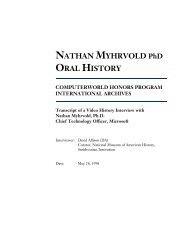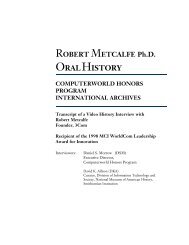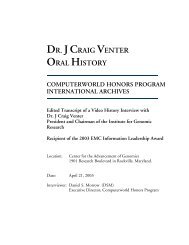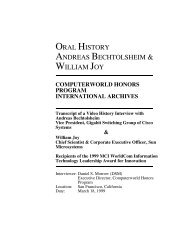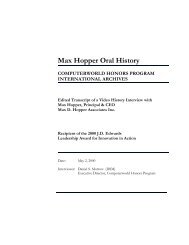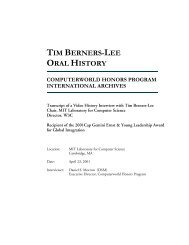NZZ Neue Zürcher Zeitung AG - The Computerworld Honors Program
NZZ Neue Zürcher Zeitung AG - The Computerworld Honors Program
NZZ Neue Zürcher Zeitung AG - The Computerworld Honors Program
Create successful ePaper yourself
Turn your PDF publications into a flip-book with our unique Google optimized e-Paper software.
LOCATION:<br />
Zurich, Switzerland<br />
YEAR:<br />
2006<br />
STATUS:<br />
Laureate<br />
CATEGORY:<br />
Media, Arts and<br />
Entertainment<br />
NOMINATING COMPANY:<br />
EMC<br />
ThE COMPUTERwORLd<br />
hONORS PROGRAM<br />
case study<br />
ORGANIZATION:<br />
<strong>NZZ</strong> <strong>Neue</strong> <strong>Zürcher</strong> <strong>Zeitung</strong> aG<br />
PROJECT NAME:<br />
archive 1780<br />
Summary<br />
In 2005, <strong>Neue</strong> <strong>Zürcher</strong> <strong>Zeitung</strong> (<strong>NZZ</strong>), switzerland’s leading newspaper, created archive 1780,<br />
a complete online archive of every page of every issue over the publication’s 225-year history.<br />
<strong>The</strong> archive 1780 team overcame major technological challenges in building the easily searchable<br />
archive of more than two million scanned newspaper pages, including text, illustrations,<br />
photographs and advertisements.<br />
available on <strong>NZZ</strong>’s web site (www.nzz.ch), archive 1780 gives the general public, including<br />
historians, journalists, students and other researchers, direct access to this unique and invaluable<br />
record. It provides a detailed, comprehensive insight into the social, political, economic and<br />
cultural life of switzerland, europe, and the wider world, not just in words but in images that<br />
convey information on major events as well as the “look and feel” of daily life over the centuries.<br />
Introductory Overview<br />
Zurich-based <strong>Neue</strong> <strong>Zürcher</strong> <strong>Zeitung</strong> is one of very few newspapers that can look back on 225<br />
years of continuous publication. Of those, it may be unique in having a complete collection of<br />
every issue published. Prior to 2005, this extremely rare archive physically resided on more than<br />
1,500 microfilms containing images of about two million newspaper pages. This film-based<br />
storage format made <strong>NZZ</strong>’s extraordinary historical archive inaccessible to all but a few people<br />
and vulnerable to physical deterioration, loss or mishandling.<br />
For the newspaper’s 225th anniversary, <strong>NZZ</strong> decided to treat itself to a special present: digitizing<br />
the entire archive and making it available online with full-text search capability. “We<br />
had dreamed of doing this for a long time,” said Rolf Brun, <strong>NZZ</strong>’s chief Information Officer.<br />
“taking into account the time span covered and the technical procedure, we believe the archive<br />
1780 project is unique in the world.”<br />
From the outset of this massive effort, <strong>NZZ</strong> decided the traditional, manual-based approach of<br />
digitization was not acceptable and instead would automate as much of the multi-step process<br />
as possible. <strong>The</strong> first step was digitizing the microfilm images of all two million printed pages.<br />
It immediately became clear that manually scanning, “cleaning” and indexing all these images<br />
HONORING tHOse WHO use INFORMatION tecHNOLOGy tO BeNeFIt sOcIety
ORGANIZATION:<br />
<strong>NZZ</strong> <strong>Neue</strong> <strong>Zürcher</strong> <strong>Zeitung</strong> <strong>AG</strong><br />
PROJECT NAME:<br />
Archiv 1780<br />
LOCATION:<br />
Zurich, Switzerland<br />
YEAR:<br />
2006<br />
STATUS:<br />
Laureate<br />
CATEGORY:<br />
Media, Arts and Entertainment<br />
NOMINATING COMPANY:<br />
EMC<br />
ThE COMPUTERwORLd hONORS PROGRAM<br />
case study<br />
would be exorbitantly expensive and take 66,000 hours or dozens of man-years to complete.<br />
In collaboration with two specialized technology and service providers, <strong>NZZ</strong> tackled the fully<br />
automated digitization of all 1,500 microfilms. While scanning the 35-mm microfilms was<br />
relatively straightforward, a number of major technical challenges arose. First, the digitization<br />
initially created very large, 80-megabyte data files per newspaper page. <strong>The</strong> size of these files had<br />
to be reduced for the project to be feasible. so the archive 1780 team employed compression<br />
techniques to reduce them to a more manageable two to four megabytes per page. While much<br />
more compact, the resulting archive 1780 database is a sizable 10 terabytes of content-addressed<br />
image data.<br />
another major technical hurdle at this stage related to some unique readability issues. <strong>The</strong><br />
microfilm images were typically photos of pages bound into books. <strong>The</strong> text was often wavy,<br />
with the book spine clearly visible in the middle. similarly, there was a wide variation in paper<br />
and print quality over the years. For example, after World War II, the newsprint was sometimes<br />
so thin that the reverse side of the page was visible on the microfilm. <strong>The</strong> <strong>NZZ</strong> team was able to<br />
use equalization and focusing without manual intervention to correct for these distortions on 95<br />
percent of its microfilm library. <strong>The</strong> remaining 5 percent of pages were in such poor condition<br />
that they had to be manually corrected for digitization.<br />
However, having cleanly scanned data was only half of the <strong>NZZ</strong> team’s digitization job. <strong>The</strong>y<br />
had to convert all the text into a machine-readable format in order to extract index data to make<br />
the archive fully searchable. and therein lay another unique challenge handed down from the<br />
past.<br />
Prior to 1946, <strong>NZZ</strong> used the traditional German Gothic type; subsequently, the newspaper<br />
converted to the antiqua font used today. However, most optical character recognition (OcR)<br />
programs do not “read” Gothic type. after an extensive search, the archive 1780 team found<br />
that abbyy FineReader XIX software did the job. even then, making the text machine-readable<br />
took two minutes per page. In order for the process not to take years, <strong>NZZ</strong> and its technology<br />
collaborators implemented a Windows cluster of 20 Pcs to handle the processing.<br />
simultaneous with the digitization process, <strong>NZZ</strong> and its partners designed, programmed and<br />
implemented a Web application for archive 1780 access. consistent with <strong>NZZ</strong>’s It policy, this<br />
application is based on open standards and open-source software. In addition, the archive is<br />
fully integrated with <strong>NZZ</strong>’s enterprise storage infrastructure.<br />
at the end of the conversion process, each newspaper page had been converted to a PdF with<br />
XML metadata for searchability. <strong>The</strong>se PdFs comprised the 10-terabyte database of contentaddressed<br />
data. since archive 1780 would consist of fixed, read-only data, a high-end storage<br />
system that supported read-write access was not necessary. tapes and other removable storage<br />
media would also not be suitable, as online research requires fast, read-only access to the whole<br />
data pool.<br />
<strong>The</strong> <strong>NZZ</strong> team met this challenge with eMc centera, which provides for cost-effective archival<br />
storage, high availability, and fast access to large, fixed-content databases up to the petabyte<br />
range. This ensures that the publicly accessible archive will be able to deliver reliable, speedy<br />
access to its content at all times. In addition, the archive will have “room to grow” as both the<br />
size of the database and volume of traffic continue to expand.<br />
since its launch in september 2005, <strong>NZZ</strong>’s archive 1780 has become one of the most popular<br />
HONORING tHOse WHO use INFORMatION tecHNOLOGy tO BeNeFIt sOcIety
ORGANIZATION:<br />
<strong>NZZ</strong> <strong>Neue</strong> <strong>Zürcher</strong> <strong>Zeitung</strong> <strong>AG</strong><br />
PROJECT NAME:<br />
Archiv 1780<br />
LOCATION:<br />
Zurich, Switzerland<br />
YEAR:<br />
2006<br />
STATUS:<br />
Laureate<br />
CATEGORY:<br />
Media, Arts and Entertainment<br />
NOMINATING COMPANY:<br />
EMC<br />
ThE COMPUTERwORLd hONORS PROGRAM<br />
case study<br />
features of <strong>NZZ</strong> Online with the number of users growing steadily each month. Most important,<br />
it gives the public an unprecedented window into recent events and the distant past.<br />
unrivalled in its scope, archive 1780 gives users fresh insight into major events, as well as the<br />
daily lives of people in switzerland, europe and the wider world for centuries past.<br />
Benefits<br />
<strong>The</strong>re are two primary beneficiaries of archive 1780: the people of switzerland and the <strong>Neue</strong><br />
<strong>Zürcher</strong> <strong>Zeitung</strong> newspaper itself, along with its parent company, <strong>NZZ</strong> Group.<br />
First of all, the innovative and technological advanced solutions <strong>NZZ</strong> applied to the creation of<br />
the database dramatically sped up what could have been an exhaustive, manual-based process<br />
lasting decades. In fact, the technological and labor costs of the traditional approach of manually<br />
scanning two millions newspaper pages into a digital format would have been a barrier to<br />
the archive 1780 ever becoming a reality.<br />
Quickly and easily available via <strong>NZZ</strong>’s web site, archive 1780 gives anyone with Internet access<br />
the ability to see – not just read – every page of every issue of switzerland’s leading newspaper.<br />
covering 225 years of continuous history, it provides a detailed, comprehensive insight into the<br />
social, political, economic and cultural life of switzerland, europe and the wider world, not just<br />
in words but in images that convey information on major events as well as the “look and feel” of<br />
daily life over the centuries.<br />
archive 1780 is an especially valuable resource for historians, students, journalists and other<br />
researchers, giving them a depth of detailed information and insight into local, national and international<br />
politics, issues and events. Previously, when the archived newspaper images resided<br />
only on microfilm, they were only available to <strong>NZZ</strong> staff and to other users upon request and<br />
approval.<br />
at the same time, archive 1780 was a vital part of <strong>Neue</strong> <strong>Zürcher</strong> <strong>Zeitung</strong>’s expansion into online<br />
publishing and a range of new business ventures. With its high-profile launch in september<br />
2005, the archive has been instrumental in driving online traffic to <strong>NZZ</strong> Web site.<br />
This has been part of <strong>NZZ</strong>’s ongoing growth into new media and communication ventures.<br />
<strong>The</strong>se include the publication of “<strong>NZZ</strong> on sunday,” the monthly magazine “<strong>NZZ</strong> Folio,” and<br />
the television program “<strong>NZZ</strong> Format.” <strong>NZZ</strong> Group now includes regional newspapers as well<br />
as commercial printers and publishers across switzerland.<br />
storing archive 1780 on the eMc centera system also has benefited both <strong>NZZ</strong> and users of<br />
the newspaper database. Because centera utilizes breakthrough c-clip technology, information<br />
is stored so it is unchangeable and secure, ensuring users of the authenticity of the information<br />
they retrieve. centera provides users with sub-second response to their requests to search<br />
through hundreds of thousands of pages, making research and other projects more efficient. In<br />
addition, users enjoy reliable, 24x7 access to the archive 1780 because centera’s self-healing<br />
architecture continuously monitors the integrity of stored objects and automatically detects and<br />
repairs software errors.<br />
Because of all of these capabilities, the <strong>NZZ</strong> It team has found centera extremely easy to manage<br />
and scale to larger capacities as the archive 1780 continues to grow with each publication<br />
day. In fact, the more information added to the centera, price per megabyte actually decreases,<br />
HONORING tHOse WHO use INFORMatION tecHNOLOGy tO BeNeFIt sOcIety
ORGANIZATION:<br />
<strong>NZZ</strong> <strong>Neue</strong> <strong>Zürcher</strong> <strong>Zeitung</strong> <strong>AG</strong><br />
PROJECT NAME:<br />
Archiv 1780<br />
LOCATION:<br />
Zurich, Switzerland<br />
YEAR:<br />
2006<br />
STATUS:<br />
Laureate<br />
CATEGORY:<br />
Media, Arts and Entertainment<br />
NOMINATING COMPANY:<br />
EMC<br />
ThE COMPUTERwORLd hONORS PROGRAM<br />
case study<br />
generating even greater cost efficiencies for <strong>NZZ</strong> in the future.<br />
<strong>The</strong> Importance of Technology<br />
From the outset, <strong>NZZ</strong> had four primary technology goals for archive 1780:<br />
•cost-effective development of online access<br />
• Full-text search capability spanning the entire archive<br />
• centralized management of content-addressed database<br />
• Integration of the archive with <strong>NZZ</strong>’s existing storage infrastructure.<br />
<strong>NZZ</strong> achieved these goals through the development of an automated, digitization process and<br />
selection of key information technologies ideally suited to its truly unique needs.<br />
<strong>NZZ</strong> recognized the traditional process of manually scanning its two-million page microfilm<br />
library into a digital format would take dozens of man-years or 66,000 hours to complete.<br />
committed to finding a fully automated way to digitize its vast microfilm library, <strong>NZZ</strong> turned<br />
to Germany’s Fraunhofer society, a vast network of research organizations, and its Institute<br />
for Media communication (IMK). With expertise gained from having created a multimedia<br />
Beethoven archive, IMK offered <strong>NZZ</strong> its support in developing a comprehensive and automated<br />
digitization process for the archive 1780 project.<br />
In 2004, <strong>NZZ</strong> asked IMK’s NetMedia competency center and the specialized scanPlex service<br />
provider to undertake the automated digitization of its 1,500 microfilms. <strong>The</strong>y applied<br />
compression techniques that reduced the size of each scanned newspaper page from 80 megabytes<br />
to two to four megabytes. Without this, implementing archive 1780 would not have<br />
been feasible. similarly, the technicians used equalization and focusing to convert 95 percent of<br />
<strong>NZZ</strong>’s microfilm library without manual intervention. as a result, what would have taken tens<br />
of thousands of hours was accomplished in approximately two months.<br />
Once it had created the digital image files, the <strong>NZZ</strong> team employed Optical character Recognition<br />
(OcR) to convert the text into machine-readable format. This was necessary in order<br />
to index the archive and make it searchable. That’s when the team discovered that most OcR<br />
programs do not read Gothic type, the standard font used by <strong>NZZ</strong> for about 160 of its 225<br />
years. ultimately, they found the abbyy FineReader XIX program, with which they overcame<br />
this problem.<br />
In keeping with <strong>NZZ</strong>’s It policy, the archive 1780 developers focused on implementing open<br />
standards and open-source technology. That included selecting MaxdB, a robust, open-source<br />
database, as the software platform for archive 1780 that integrated with <strong>NZZ</strong>’s saP application<br />
environment. In building the Web application for accessing the archive, the team made sure it<br />
integrated with the apache Lenya Java/XML open-source content management system used by<br />
<strong>NZZ</strong>.<br />
a key component in making archive 1780 feasible from both a technology and business perspective<br />
is eMc centera, a data storage system designed for archiving fixed, content-addressed<br />
data. Further, <strong>NZZ</strong> recognized it did not need read-write access and frequent backup capabilities<br />
provided by higher-end storage systems for essentially static, read-only data characteristic<br />
of archive 1780. <strong>The</strong>refore, it chose a more cost-effective, object-oriented storage system that<br />
HONORING tHOse WHO use INFORMatION tecHNOLOGy tO BeNeFIt sOcIety
ORGANIZATION:<br />
<strong>NZZ</strong> <strong>Neue</strong> <strong>Zürcher</strong> <strong>Zeitung</strong> <strong>AG</strong><br />
PROJECT NAME:<br />
Archiv 1780<br />
LOCATION:<br />
Zurich, Switzerland<br />
YEAR:<br />
2006<br />
STATUS:<br />
Laureate<br />
CATEGORY:<br />
Media, Arts and Entertainment<br />
NOMINATING COMPANY:<br />
EMC<br />
ThE COMPUTERwORLd hONORS PROGRAM<br />
case study<br />
also provided centralized data management and ensured maximum integrity of archives over the<br />
long term.<br />
Originality<br />
archive 1780 and the development process that created it epitomize innovation and originality<br />
on many different levels. <strong>The</strong> nature of the online archive itself is unique: there is no other<br />
comprehensive, Web-accessible newspaper database of all issues published over the span of 225<br />
years. after considerable research, <strong>NZZ</strong> knows of no comparable online archive. Rolf Brun,<br />
<strong>NZZ</strong>’s chief Information Officer, noted, “Regarding the time span covered and the technical<br />
procedure, we believe this project is unique in the world,”<br />
creating a searchable online archive of the size and scope of archive 1780 was extremely ambitious<br />
and innovative. <strong>NZZ</strong> and its technology collaborators truly “pushed the technology<br />
envelope” in overcoming numerous technology challenges in making archive 1780 a reality.<br />
<strong>The</strong>se include:<br />
• automating the digitization of more than two million microfilm images,<br />
• employing compression, equalization and focusing techniques to overcome issues related to<br />
the size of data files and the legibility of extremely old, often distorted text and images,<br />
• Overcoming challenges to machine-readability based on differences in typefaces over the years,<br />
• Indexing the entire archive 1780 database, enabling users to easily search for, identify, and access<br />
specific topics and publications by date and topic,<br />
• developing the open-source Web application to make this accessibility possible,<br />
• designing, developing and implementing an archival, cost-effective content-addressed storage<br />
system for read-only information and access.<br />
Success<br />
Thanks to the collaborative efforts of <strong>NZZ</strong>’s It team and its collaborators, the archive 1780<br />
was successfully launched in september 2005. <strong>The</strong> archive has achieved all the goals defined by<br />
<strong>NZZ</strong> at the outset of the project. It delivers fast, easy access for any Internet user to switzerland’s<br />
political, social, economic and cultural life over the past 225 years. In a sense, it enables<br />
archive users a chance to “eavesdrop” on the views and values of people over the centuries.<br />
People who have successfully used archive 1780 to find information and expand their cultural<br />
awareness range from casual users to professional researchers, academics and others. <strong>The</strong> archive<br />
makes it easy for <strong>NZZ</strong> journalists to read the newspaper’s previous coverage on topics to gain<br />
insight and background information. In addition, archive 1780 lets general public users do<br />
“recreational” searches such as finding the <strong>NZZ</strong> issue that was published on their birth date.<br />
From a business perspective, archive 1780 has firmly established <strong>NZZ</strong> as a technology leader<br />
among print publications that have successfully expanded into the online arena. seizing the opportunity<br />
presented by its 225th anniversary, <strong>NZZ</strong> pursued the archive 1780 initiative to raise<br />
its profile among its readership and the general public. It gave <strong>NZZ</strong> a new, revenue-generating<br />
profit center out of what had previously been an incredibly valuable but hidden, under-utilized<br />
HONORING tHOse WHO use INFORMatION tecHNOLOGy tO BeNeFIt sOcIety
ORGANIZATION:<br />
<strong>NZZ</strong> <strong>Neue</strong> <strong>Zürcher</strong> <strong>Zeitung</strong> <strong>AG</strong><br />
PROJECT NAME:<br />
Archiv 1780<br />
LOCATION:<br />
Zurich, Switzerland<br />
YEAR:<br />
2006<br />
STATUS:<br />
Laureate<br />
CATEGORY:<br />
Media, Arts and Entertainment<br />
NOMINATING COMPANY:<br />
EMC<br />
ThE COMPUTERwORLd hONORS PROGRAM<br />
case study<br />
resource. By attracting more visitors to the <strong>NZZ</strong> Online Web site, archive 1780 has proved<br />
instrumental in boosting the profitability of its online presence.<br />
<strong>The</strong> archive 1780 project successfully employed a wide range of technologies, including:<br />
• Fully automated digitization of its vast microfilm library,<br />
• Processing of image data without -- or with a minimum of -- manual assistance,<br />
• Implementation of OcR and full-text indexing of microfilms,<br />
• development of the client-specific Web application,<br />
• Integration of the archive 1780 interface into the archival storage system.<br />
In the end, the archive 1780 project is an outstanding example of how a content provider and<br />
outside service providers can work together to turn a technology vision into reality.<br />
difficulty<br />
With enthusiastic, supportive senior management at <strong>NZZ</strong>, the challenges faced by the archive<br />
1780 team were exclusively technical ones. One of the biggest hurdles was due to the sheer volume<br />
of two million microfilm images that had to be digitized. Manually scanning, “cleaning”<br />
and indexing all these images would have been exorbitantly expensive and taken dozens of manyears<br />
to complete. <strong>The</strong> team addressed this by automating the digitizing process, which reduced<br />
the time involved from what would have been more than 66,000 hours to about two months.<br />
<strong>The</strong> automation process itself involved a number of technological difficulties, which <strong>NZZ</strong><br />
and its development partners, resolved. <strong>The</strong> first was discovering that the digitization initially<br />
created very large, 80-megabyte data files per newspaper page. <strong>The</strong> size of these files had to<br />
be reduced for the project to be feasible. so the archive 1780 team employed compression<br />
techniques to reduce them to a more manageable two to four megabytes per page. While much<br />
more compact, the resulting archive 1780 database is a sizable 10 terabytes of content-addressed<br />
image data.<br />
another major technical hurdle at this stage related to some unique readability issues. <strong>The</strong><br />
microfilm images were typically photos of pages bound into books. <strong>The</strong> text was often wavy,<br />
with the book spine clearly visible in the middle. similarly, there was a wide variation in paper<br />
and print quality over the years. For example, after World War II, the newsprint was sometimes<br />
so thin that the reverse side of the page was visible on the microfilm. <strong>The</strong> <strong>NZZ</strong> team was able<br />
to use equalization and focusing without manual intervention to correct for these distortions<br />
on 95 percent of its microfilm library. <strong>The</strong> remaining five percent of pages were in such poor<br />
condition that they had to be manually corrected for digitization.<br />
Once this data was cleanly scanned, the archive 1780 team faced a new challenge in enabling<br />
OcR technology to “read” the content-addressed data. Prior to 1946, the newspaper used the<br />
traditional German Gothic type; subsequently, they converted to the antiqua font used today.<br />
<strong>The</strong> team found that most optical character recognition (OcR) programs do not “read” Gothic<br />
type. after an extensive search, they found abbyy FineReader XIX software, which did the job.<br />
even then, making the text machine-readable took two minutes per page. In order for the process<br />
not to take years, <strong>NZZ</strong> and its technology collaborators implemented a Windows cluster of<br />
20 Pcs to handle the processing.<br />
HONORING tHOse WHO use INFORMatION tecHNOLOGy tO BeNeFIt sOcIety




